Principles of Administration Report: Office Management at 4Com
VerifiedAdded on 2020/06/04
|14
|4024
|45
Report
AI Summary
This report provides a detailed analysis of the principles of administration, focusing on practical applications within a business context, using 4Com as a case study. It explores legal requirements for office facility management, including contracts and service provision, alongside the importance of establishing clear office management procedures and efficient resource utilization. The report delves into workplace health and safety, outlining employer and employee responsibilities, as well as accident and emergency protocols. It also examines meeting management, including minute-taking, legal implications, and the roles of meeting participants. Furthermore, the report addresses workload management through targets and budgets, work allocation, and quality management techniques. Finally, it covers event planning, detailing event characteristics, information gathering, and resource identification. The report emphasizes the importance of administrative practices for effective business operations and employee welfare.
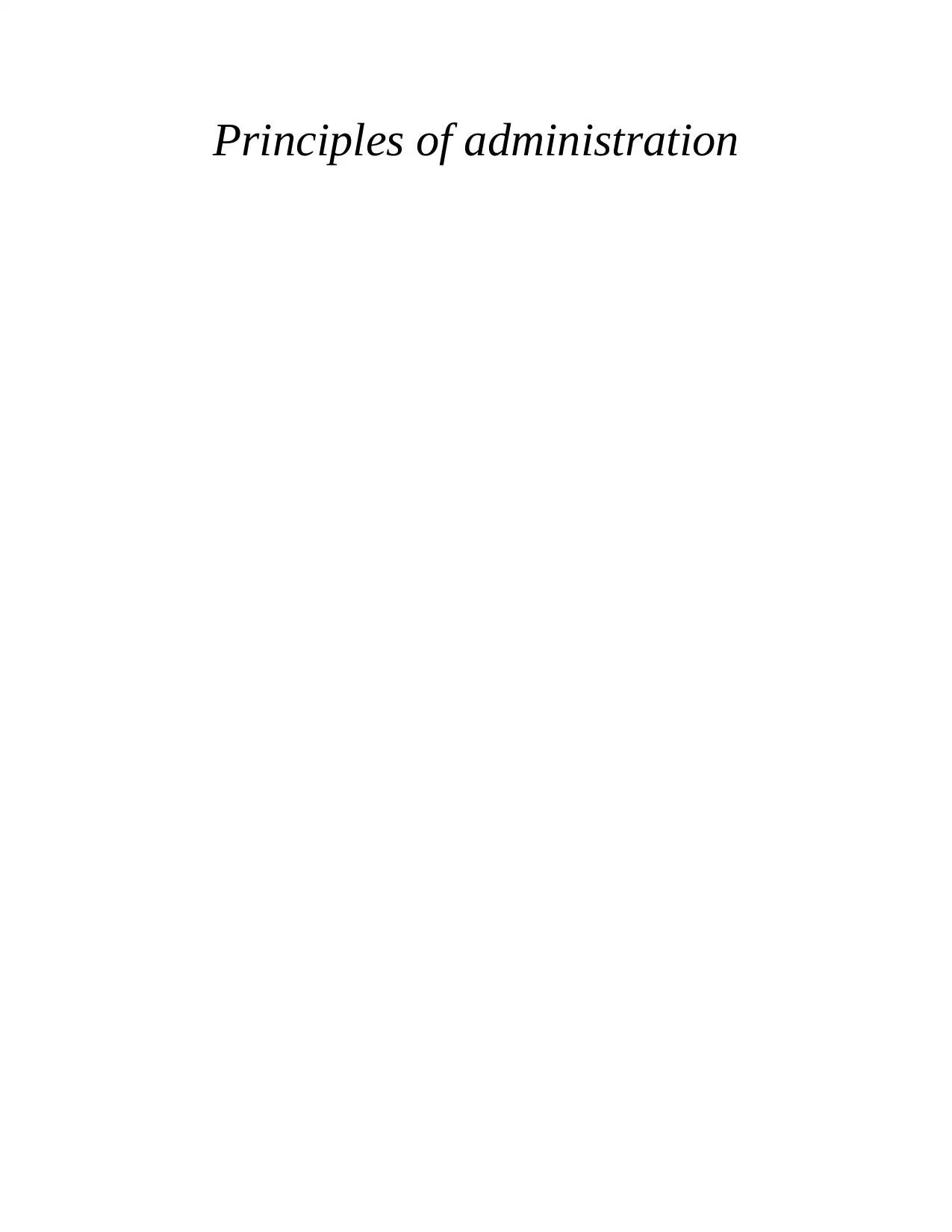
Principles of administration
Paraphrase This Document
Need a fresh take? Get an instant paraphrase of this document with our AI Paraphraser
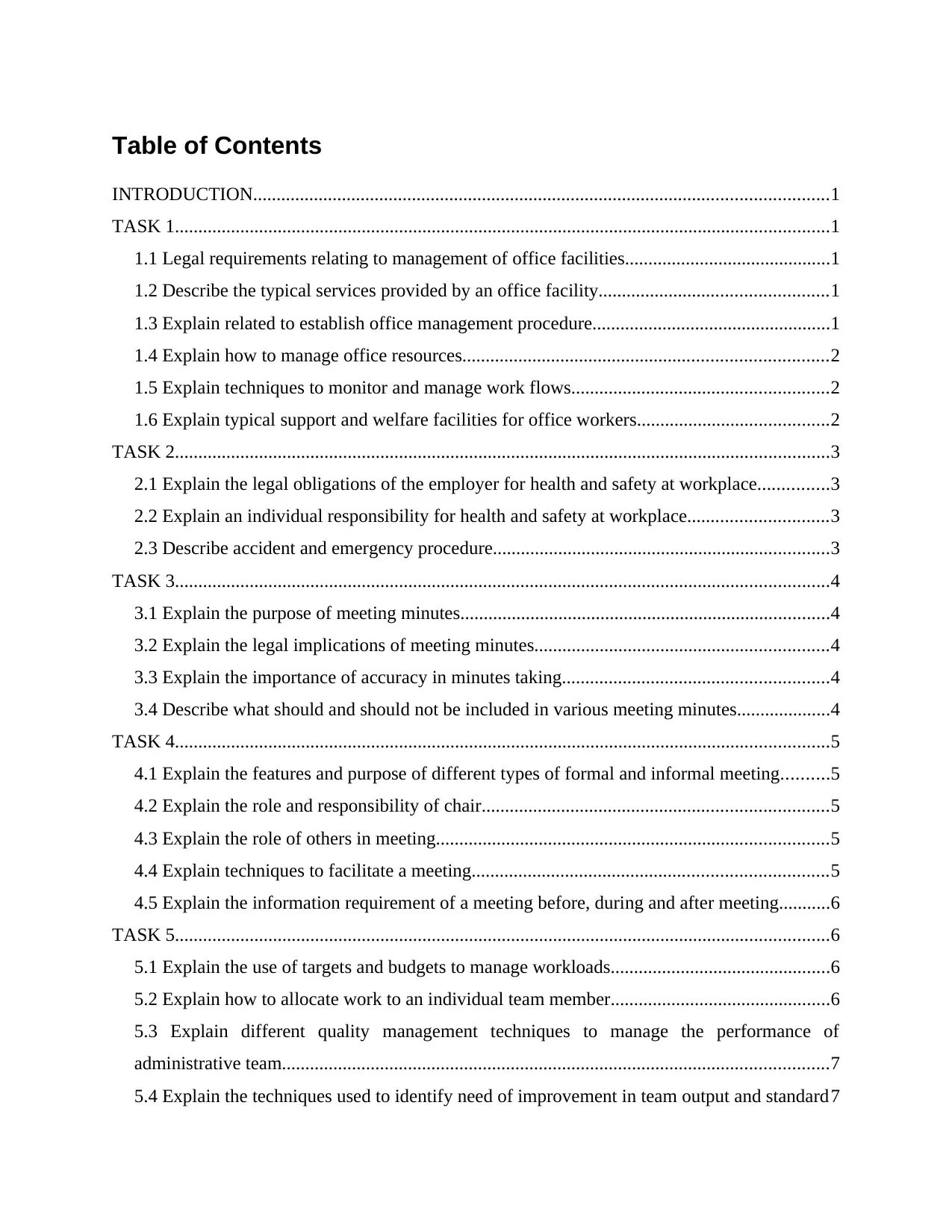
Table of Contents
INTRODUCTION...........................................................................................................................1
TASK 1............................................................................................................................................1
1.1 Legal requirements relating to management of office facilities............................................1
1.2 Describe the typical services provided by an office facility.................................................1
1.3 Explain related to establish office management procedure...................................................1
1.4 Explain how to manage office resources..............................................................................2
1.5 Explain techniques to monitor and manage work flows.......................................................2
1.6 Explain typical support and welfare facilities for office workers.........................................2
TASK 2............................................................................................................................................3
2.1 Explain the legal obligations of the employer for health and safety at workplace...............3
2.2 Explain an individual responsibility for health and safety at workplace..............................3
2.3 Describe accident and emergency procedure........................................................................3
TASK 3............................................................................................................................................4
3.1 Explain the purpose of meeting minutes...............................................................................4
3.2 Explain the legal implications of meeting minutes...............................................................4
3.3 Explain the importance of accuracy in minutes taking.........................................................4
3.4 Describe what should and should not be included in various meeting minutes....................4
TASK 4............................................................................................................................................5
4.1 Explain the features and purpose of different types of formal and informal meeting..........5
4.2 Explain the role and responsibility of chair..........................................................................5
4.3 Explain the role of others in meeting....................................................................................5
4.4 Explain techniques to facilitate a meeting............................................................................5
4.5 Explain the information requirement of a meeting before, during and after meeting...........6
TASK 5............................................................................................................................................6
5.1 Explain the use of targets and budgets to manage workloads...............................................6
5.2 Explain how to allocate work to an individual team member...............................................6
5.3 Explain different quality management techniques to manage the performance of
administrative team.....................................................................................................................7
5.4 Explain the techniques used to identify need of improvement in team output and standard7
INTRODUCTION...........................................................................................................................1
TASK 1............................................................................................................................................1
1.1 Legal requirements relating to management of office facilities............................................1
1.2 Describe the typical services provided by an office facility.................................................1
1.3 Explain related to establish office management procedure...................................................1
1.4 Explain how to manage office resources..............................................................................2
1.5 Explain techniques to monitor and manage work flows.......................................................2
1.6 Explain typical support and welfare facilities for office workers.........................................2
TASK 2............................................................................................................................................3
2.1 Explain the legal obligations of the employer for health and safety at workplace...............3
2.2 Explain an individual responsibility for health and safety at workplace..............................3
2.3 Describe accident and emergency procedure........................................................................3
TASK 3............................................................................................................................................4
3.1 Explain the purpose of meeting minutes...............................................................................4
3.2 Explain the legal implications of meeting minutes...............................................................4
3.3 Explain the importance of accuracy in minutes taking.........................................................4
3.4 Describe what should and should not be included in various meeting minutes....................4
TASK 4............................................................................................................................................5
4.1 Explain the features and purpose of different types of formal and informal meeting..........5
4.2 Explain the role and responsibility of chair..........................................................................5
4.3 Explain the role of others in meeting....................................................................................5
4.4 Explain techniques to facilitate a meeting............................................................................5
4.5 Explain the information requirement of a meeting before, during and after meeting...........6
TASK 5............................................................................................................................................6
5.1 Explain the use of targets and budgets to manage workloads...............................................6
5.2 Explain how to allocate work to an individual team member...............................................6
5.3 Explain different quality management techniques to manage the performance of
administrative team.....................................................................................................................7
5.4 Explain the techniques used to identify need of improvement in team output and standard7

TASK 6............................................................................................................................................7
6.1 Explain characteristics, requirements and purpose of different types of events...................7
6.2 Explain the types of information and its sources needed to organise an event.....................8
6.3 Explain how to plan an event................................................................................................8
6.4 Explain how to identify the right resources from an event plan...........................................8
6.5 Describe the likely types of information needed by delegates before, during and after an
event............................................................................................................................................9
CONCLUSION................................................................................................................................9
REFERENCES..............................................................................................................................10
6.1 Explain characteristics, requirements and purpose of different types of events...................7
6.2 Explain the types of information and its sources needed to organise an event.....................8
6.3 Explain how to plan an event................................................................................................8
6.4 Explain how to identify the right resources from an event plan...........................................8
6.5 Describe the likely types of information needed by delegates before, during and after an
event............................................................................................................................................9
CONCLUSION................................................................................................................................9
REFERENCES..............................................................................................................................10
⊘ This is a preview!⊘
Do you want full access?
Subscribe today to unlock all pages.

Trusted by 1+ million students worldwide
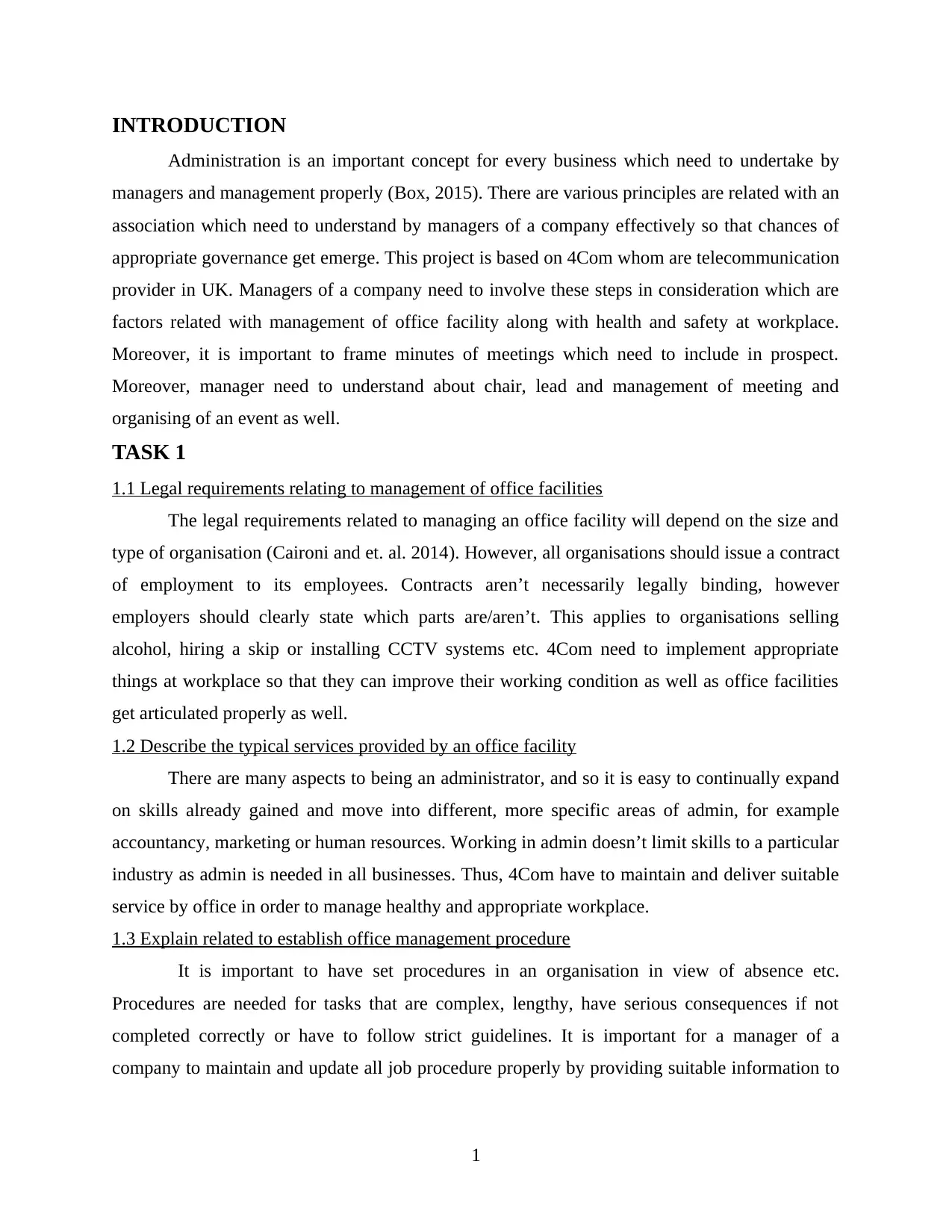
INTRODUCTION
Administration is an important concept for every business which need to undertake by
managers and management properly (Box, 2015). There are various principles are related with an
association which need to understand by managers of a company effectively so that chances of
appropriate governance get emerge. This project is based on 4Com whom are telecommunication
provider in UK. Managers of a company need to involve these steps in consideration which are
factors related with management of office facility along with health and safety at workplace.
Moreover, it is important to frame minutes of meetings which need to include in prospect.
Moreover, manager need to understand about chair, lead and management of meeting and
organising of an event as well.
TASK 1
1.1 Legal requirements relating to management of office facilities
The legal requirements related to managing an office facility will depend on the size and
type of organisation (Caironi and et. al. 2014). However, all organisations should issue a contract
of employment to its employees. Contracts aren’t necessarily legally binding, however
employers should clearly state which parts are/aren’t. This applies to organisations selling
alcohol, hiring a skip or installing CCTV systems etc. 4Com need to implement appropriate
things at workplace so that they can improve their working condition as well as office facilities
get articulated properly as well.
1.2 Describe the typical services provided by an office facility
There are many aspects to being an administrator, and so it is easy to continually expand
on skills already gained and move into different, more specific areas of admin, for example
accountancy, marketing or human resources. Working in admin doesn’t limit skills to a particular
industry as admin is needed in all businesses. Thus, 4Com have to maintain and deliver suitable
service by office in order to manage healthy and appropriate workplace.
1.3 Explain related to establish office management procedure
It is important to have set procedures in an organisation in view of absence etc.
Procedures are needed for tasks that are complex, lengthy, have serious consequences if not
completed correctly or have to follow strict guidelines. It is important for a manager of a
company to maintain and update all job procedure properly by providing suitable information to
1
Administration is an important concept for every business which need to undertake by
managers and management properly (Box, 2015). There are various principles are related with an
association which need to understand by managers of a company effectively so that chances of
appropriate governance get emerge. This project is based on 4Com whom are telecommunication
provider in UK. Managers of a company need to involve these steps in consideration which are
factors related with management of office facility along with health and safety at workplace.
Moreover, it is important to frame minutes of meetings which need to include in prospect.
Moreover, manager need to understand about chair, lead and management of meeting and
organising of an event as well.
TASK 1
1.1 Legal requirements relating to management of office facilities
The legal requirements related to managing an office facility will depend on the size and
type of organisation (Caironi and et. al. 2014). However, all organisations should issue a contract
of employment to its employees. Contracts aren’t necessarily legally binding, however
employers should clearly state which parts are/aren’t. This applies to organisations selling
alcohol, hiring a skip or installing CCTV systems etc. 4Com need to implement appropriate
things at workplace so that they can improve their working condition as well as office facilities
get articulated properly as well.
1.2 Describe the typical services provided by an office facility
There are many aspects to being an administrator, and so it is easy to continually expand
on skills already gained and move into different, more specific areas of admin, for example
accountancy, marketing or human resources. Working in admin doesn’t limit skills to a particular
industry as admin is needed in all businesses. Thus, 4Com have to maintain and deliver suitable
service by office in order to manage healthy and appropriate workplace.
1.3 Explain related to establish office management procedure
It is important to have set procedures in an organisation in view of absence etc.
Procedures are needed for tasks that are complex, lengthy, have serious consequences if not
completed correctly or have to follow strict guidelines. It is important for a manager of a
company to maintain and update all job procedure properly by providing suitable information to
1
Paraphrase This Document
Need a fresh take? Get an instant paraphrase of this document with our AI Paraphraser

each and every person. 4Com need to provide appropriate data to each and every manager or
employee related with work so that effective administration could be maintain.
1.4 Explain how to manage office resources
Managing resources is the process of making sure resources are used in the most efficient
way (De Vries and Nemec, 2013). Office resources include materials, staff, information and
equipment. Managing resources includes making sure an organisation has enough physical
resources, but not an overabundance, and making sure employees are given tasks and duties that
will keep them occupied throughout the day. Using resources efficiently helps reduce costs to the
organisation, as well as reducing energy costs. 4Com is a telecommunication company whom
need to manage their resources properly whether they are labour or other. Unnecessary utilisation
of resources harms quality of work as well as services of a company.
1.5 Explain techniques to monitor and manage work flows
Work flows are the processes in which tasks are completed, most processes include many
steps, exchanging and passing on information, and interactions between different people in
different departments (Hay, 2011). Workflow management is important as organisations need to
be able to understand and determine what tasks need to be executed, what order they need to be
completed in, who’s involved, what systems are being used and if the rules are being followed.
4Com managers need to facilitate appropriate administration at workplace by monitoring various
operations in an appropriate frame. Along with this, work flow need to get manage effectively so
that chances of better and effective gain get promoted in order for best suited outcome.
1.6 Explain typical support and welfare facilities for office workers
All workplaces should offer appropriate support facilities for its employees. This support
may include advice and guidance to anyone affected by a personal or work-related problem, by
helping them reach a positive solution.
It is a legal requirement to ensure there are suitable welfare facilities provided for
employees. These facilities must include; a toilet, somewhere to wash, rest and change if
necessary and a suitable seating area to eat and drink during breaks, where food will not get
contaminated. 4Com need to provide appropriate facilities to all office workers which enables
them in order to maintain motivated workforce whom already work in welfare of an association.
2
employee related with work so that effective administration could be maintain.
1.4 Explain how to manage office resources
Managing resources is the process of making sure resources are used in the most efficient
way (De Vries and Nemec, 2013). Office resources include materials, staff, information and
equipment. Managing resources includes making sure an organisation has enough physical
resources, but not an overabundance, and making sure employees are given tasks and duties that
will keep them occupied throughout the day. Using resources efficiently helps reduce costs to the
organisation, as well as reducing energy costs. 4Com is a telecommunication company whom
need to manage their resources properly whether they are labour or other. Unnecessary utilisation
of resources harms quality of work as well as services of a company.
1.5 Explain techniques to monitor and manage work flows
Work flows are the processes in which tasks are completed, most processes include many
steps, exchanging and passing on information, and interactions between different people in
different departments (Hay, 2011). Workflow management is important as organisations need to
be able to understand and determine what tasks need to be executed, what order they need to be
completed in, who’s involved, what systems are being used and if the rules are being followed.
4Com managers need to facilitate appropriate administration at workplace by monitoring various
operations in an appropriate frame. Along with this, work flow need to get manage effectively so
that chances of better and effective gain get promoted in order for best suited outcome.
1.6 Explain typical support and welfare facilities for office workers
All workplaces should offer appropriate support facilities for its employees. This support
may include advice and guidance to anyone affected by a personal or work-related problem, by
helping them reach a positive solution.
It is a legal requirement to ensure there are suitable welfare facilities provided for
employees. These facilities must include; a toilet, somewhere to wash, rest and change if
necessary and a suitable seating area to eat and drink during breaks, where food will not get
contaminated. 4Com need to provide appropriate facilities to all office workers which enables
them in order to maintain motivated workforce whom already work in welfare of an association.
2
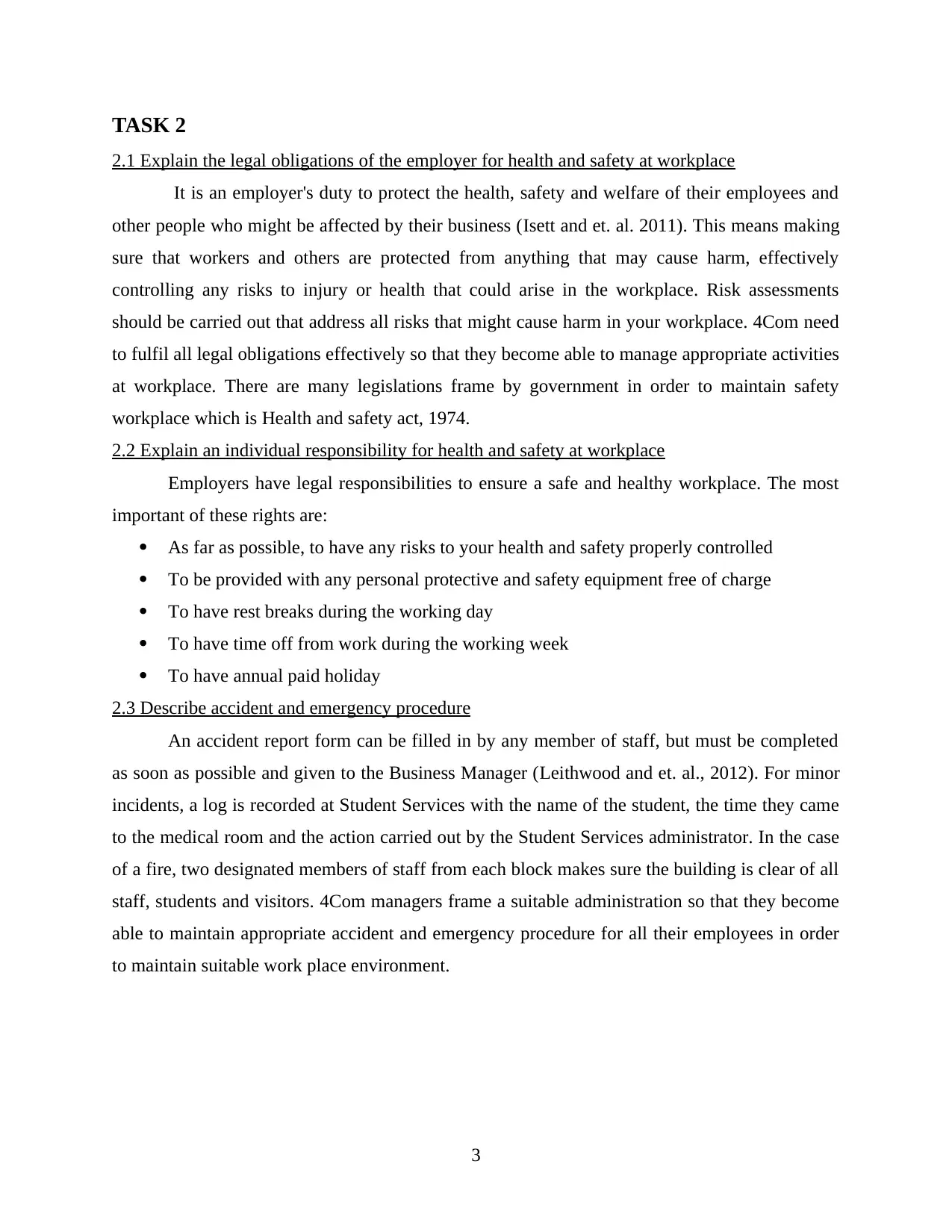
TASK 2
2.1 Explain the legal obligations of the employer for health and safety at workplace
It is an employer's duty to protect the health, safety and welfare of their employees and
other people who might be affected by their business (Isett and et. al. 2011). This means making
sure that workers and others are protected from anything that may cause harm, effectively
controlling any risks to injury or health that could arise in the workplace. Risk assessments
should be carried out that address all risks that might cause harm in your workplace. 4Com need
to fulfil all legal obligations effectively so that they become able to manage appropriate activities
at workplace. There are many legislations frame by government in order to maintain safety
workplace which is Health and safety act, 1974.
2.2 Explain an individual responsibility for health and safety at workplace
Employers have legal responsibilities to ensure a safe and healthy workplace. The most
important of these rights are:
As far as possible, to have any risks to your health and safety properly controlled
To be provided with any personal protective and safety equipment free of charge
To have rest breaks during the working day
To have time off from work during the working week
To have annual paid holiday
2.3 Describe accident and emergency procedure
An accident report form can be filled in by any member of staff, but must be completed
as soon as possible and given to the Business Manager (Leithwood and et. al., 2012). For minor
incidents, a log is recorded at Student Services with the name of the student, the time they came
to the medical room and the action carried out by the Student Services administrator. In the case
of a fire, two designated members of staff from each block makes sure the building is clear of all
staff, students and visitors. 4Com managers frame a suitable administration so that they become
able to maintain appropriate accident and emergency procedure for all their employees in order
to maintain suitable work place environment.
3
2.1 Explain the legal obligations of the employer for health and safety at workplace
It is an employer's duty to protect the health, safety and welfare of their employees and
other people who might be affected by their business (Isett and et. al. 2011). This means making
sure that workers and others are protected from anything that may cause harm, effectively
controlling any risks to injury or health that could arise in the workplace. Risk assessments
should be carried out that address all risks that might cause harm in your workplace. 4Com need
to fulfil all legal obligations effectively so that they become able to manage appropriate activities
at workplace. There are many legislations frame by government in order to maintain safety
workplace which is Health and safety act, 1974.
2.2 Explain an individual responsibility for health and safety at workplace
Employers have legal responsibilities to ensure a safe and healthy workplace. The most
important of these rights are:
As far as possible, to have any risks to your health and safety properly controlled
To be provided with any personal protective and safety equipment free of charge
To have rest breaks during the working day
To have time off from work during the working week
To have annual paid holiday
2.3 Describe accident and emergency procedure
An accident report form can be filled in by any member of staff, but must be completed
as soon as possible and given to the Business Manager (Leithwood and et. al., 2012). For minor
incidents, a log is recorded at Student Services with the name of the student, the time they came
to the medical room and the action carried out by the Student Services administrator. In the case
of a fire, two designated members of staff from each block makes sure the building is clear of all
staff, students and visitors. 4Com managers frame a suitable administration so that they become
able to maintain appropriate accident and emergency procedure for all their employees in order
to maintain suitable work place environment.
3
⊘ This is a preview!⊘
Do you want full access?
Subscribe today to unlock all pages.

Trusted by 1+ million students worldwide
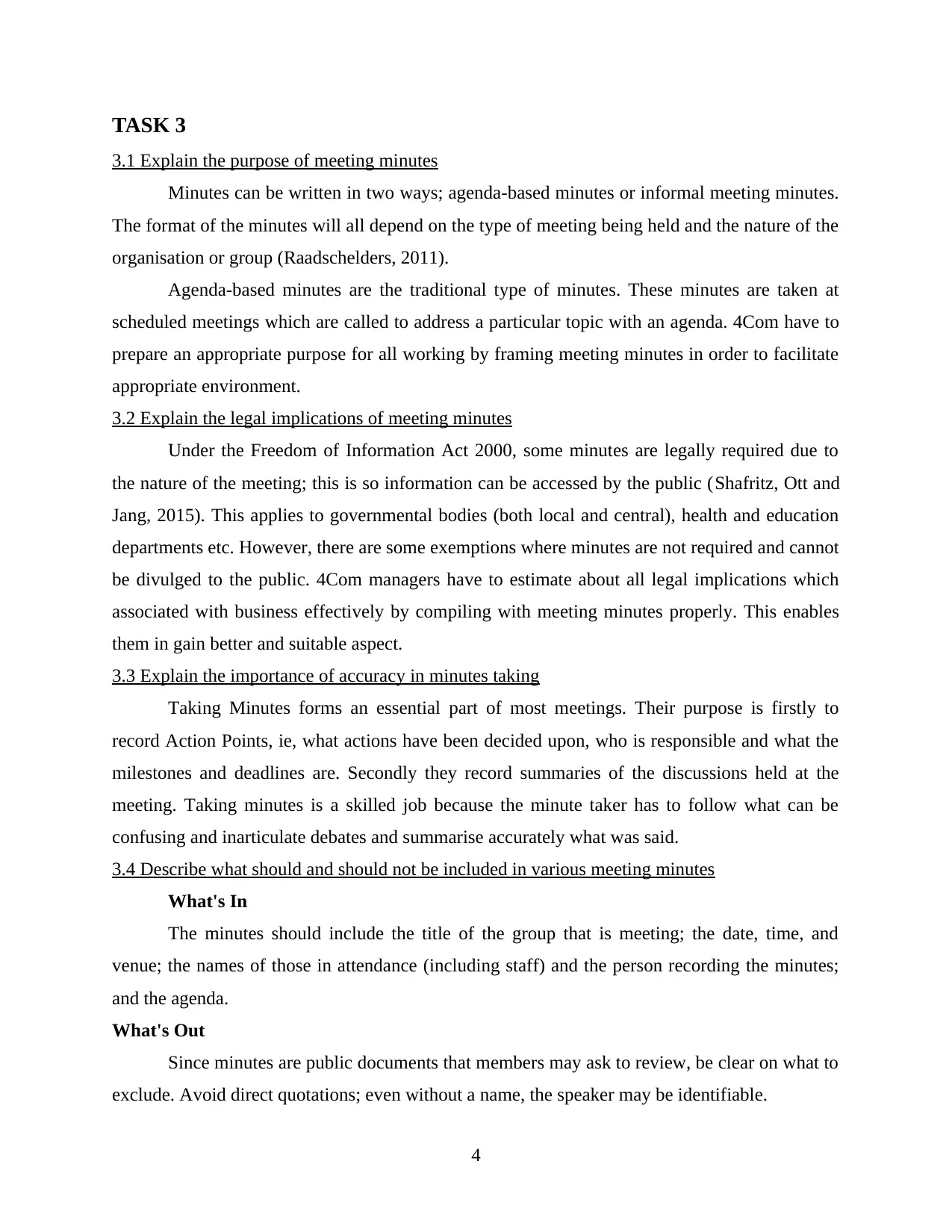
TASK 3
3.1 Explain the purpose of meeting minutes
Minutes can be written in two ways; agenda-based minutes or informal meeting minutes.
The format of the minutes will all depend on the type of meeting being held and the nature of the
organisation or group (Raadschelders, 2011).
Agenda-based minutes are the traditional type of minutes. These minutes are taken at
scheduled meetings which are called to address a particular topic with an agenda. 4Com have to
prepare an appropriate purpose for all working by framing meeting minutes in order to facilitate
appropriate environment.
3.2 Explain the legal implications of meeting minutes
Under the Freedom of Information Act 2000, some minutes are legally required due to
the nature of the meeting; this is so information can be accessed by the public (Shafritz, Ott and
Jang, 2015). This applies to governmental bodies (both local and central), health and education
departments etc. However, there are some exemptions where minutes are not required and cannot
be divulged to the public. 4Com managers have to estimate about all legal implications which
associated with business effectively by compiling with meeting minutes properly. This enables
them in gain better and suitable aspect.
3.3 Explain the importance of accuracy in minutes taking
Taking Minutes forms an essential part of most meetings. Their purpose is firstly to
record Action Points, ie, what actions have been decided upon, who is responsible and what the
milestones and deadlines are. Secondly they record summaries of the discussions held at the
meeting. Taking minutes is a skilled job because the minute taker has to follow what can be
confusing and inarticulate debates and summarise accurately what was said.
3.4 Describe what should and should not be included in various meeting minutes
What's In
The minutes should include the title of the group that is meeting; the date, time, and
venue; the names of those in attendance (including staff) and the person recording the minutes;
and the agenda.
What's Out
Since minutes are public documents that members may ask to review, be clear on what to
exclude. Avoid direct quotations; even without a name, the speaker may be identifiable.
4
3.1 Explain the purpose of meeting minutes
Minutes can be written in two ways; agenda-based minutes or informal meeting minutes.
The format of the minutes will all depend on the type of meeting being held and the nature of the
organisation or group (Raadschelders, 2011).
Agenda-based minutes are the traditional type of minutes. These minutes are taken at
scheduled meetings which are called to address a particular topic with an agenda. 4Com have to
prepare an appropriate purpose for all working by framing meeting minutes in order to facilitate
appropriate environment.
3.2 Explain the legal implications of meeting minutes
Under the Freedom of Information Act 2000, some minutes are legally required due to
the nature of the meeting; this is so information can be accessed by the public (Shafritz, Ott and
Jang, 2015). This applies to governmental bodies (both local and central), health and education
departments etc. However, there are some exemptions where minutes are not required and cannot
be divulged to the public. 4Com managers have to estimate about all legal implications which
associated with business effectively by compiling with meeting minutes properly. This enables
them in gain better and suitable aspect.
3.3 Explain the importance of accuracy in minutes taking
Taking Minutes forms an essential part of most meetings. Their purpose is firstly to
record Action Points, ie, what actions have been decided upon, who is responsible and what the
milestones and deadlines are. Secondly they record summaries of the discussions held at the
meeting. Taking minutes is a skilled job because the minute taker has to follow what can be
confusing and inarticulate debates and summarise accurately what was said.
3.4 Describe what should and should not be included in various meeting minutes
What's In
The minutes should include the title of the group that is meeting; the date, time, and
venue; the names of those in attendance (including staff) and the person recording the minutes;
and the agenda.
What's Out
Since minutes are public documents that members may ask to review, be clear on what to
exclude. Avoid direct quotations; even without a name, the speaker may be identifiable.
4
Paraphrase This Document
Need a fresh take? Get an instant paraphrase of this document with our AI Paraphraser
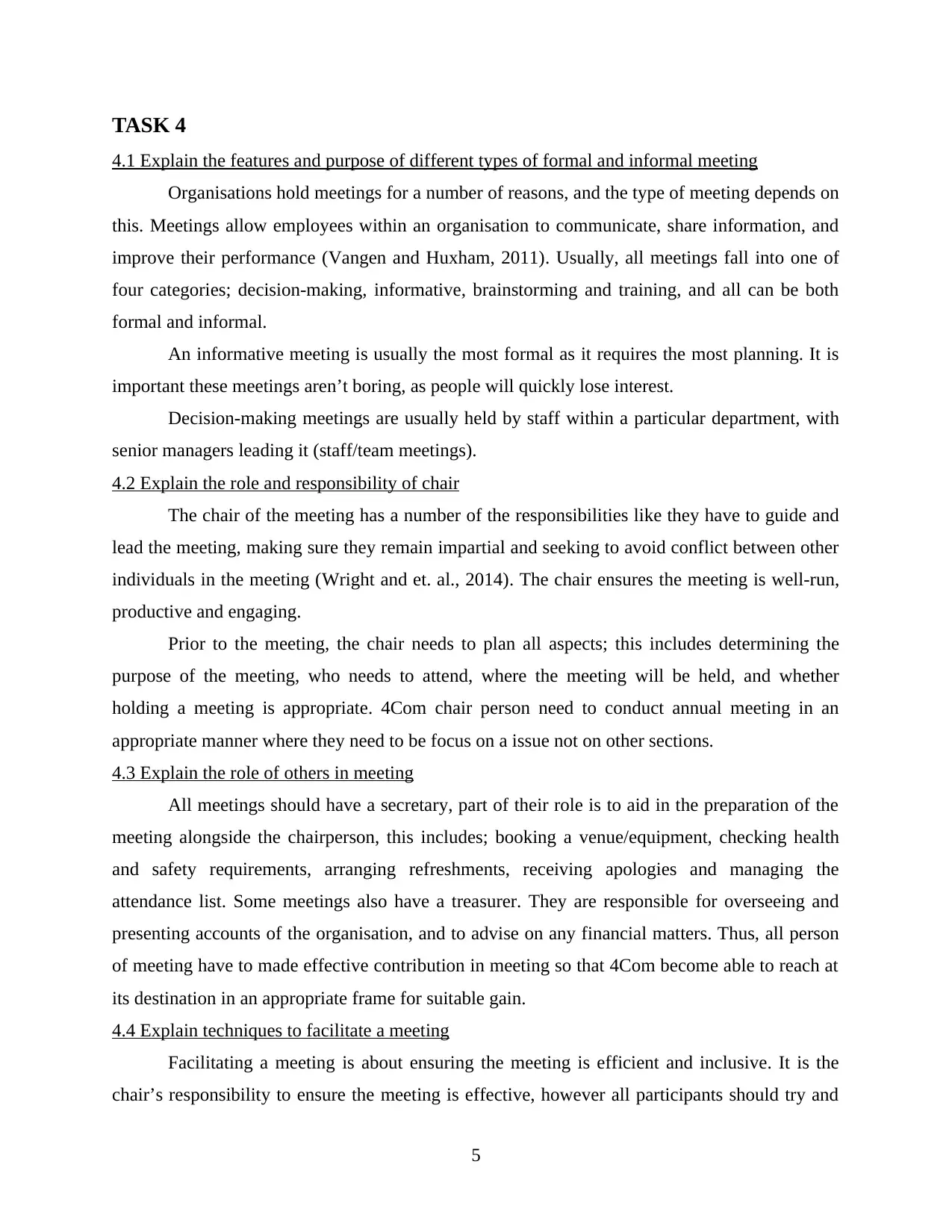
TASK 4
4.1 Explain the features and purpose of different types of formal and informal meeting
Organisations hold meetings for a number of reasons, and the type of meeting depends on
this. Meetings allow employees within an organisation to communicate, share information, and
improve their performance (Vangen and Huxham, 2011). Usually, all meetings fall into one of
four categories; decision-making, informative, brainstorming and training, and all can be both
formal and informal.
An informative meeting is usually the most formal as it requires the most planning. It is
important these meetings aren’t boring, as people will quickly lose interest.
Decision-making meetings are usually held by staff within a particular department, with
senior managers leading it (staff/team meetings).
4.2 Explain the role and responsibility of chair
The chair of the meeting has a number of the responsibilities like they have to guide and
lead the meeting, making sure they remain impartial and seeking to avoid conflict between other
individuals in the meeting (Wright and et. al., 2014). The chair ensures the meeting is well-run,
productive and engaging.
Prior to the meeting, the chair needs to plan all aspects; this includes determining the
purpose of the meeting, who needs to attend, where the meeting will be held, and whether
holding a meeting is appropriate. 4Com chair person need to conduct annual meeting in an
appropriate manner where they need to be focus on a issue not on other sections.
4.3 Explain the role of others in meeting
All meetings should have a secretary, part of their role is to aid in the preparation of the
meeting alongside the chairperson, this includes; booking a venue/equipment, checking health
and safety requirements, arranging refreshments, receiving apologies and managing the
attendance list. Some meetings also have a treasurer. They are responsible for overseeing and
presenting accounts of the organisation, and to advise on any financial matters. Thus, all person
of meeting have to made effective contribution in meeting so that 4Com become able to reach at
its destination in an appropriate frame for suitable gain.
4.4 Explain techniques to facilitate a meeting
Facilitating a meeting is about ensuring the meeting is efficient and inclusive. It is the
chair’s responsibility to ensure the meeting is effective, however all participants should try and
5
4.1 Explain the features and purpose of different types of formal and informal meeting
Organisations hold meetings for a number of reasons, and the type of meeting depends on
this. Meetings allow employees within an organisation to communicate, share information, and
improve their performance (Vangen and Huxham, 2011). Usually, all meetings fall into one of
four categories; decision-making, informative, brainstorming and training, and all can be both
formal and informal.
An informative meeting is usually the most formal as it requires the most planning. It is
important these meetings aren’t boring, as people will quickly lose interest.
Decision-making meetings are usually held by staff within a particular department, with
senior managers leading it (staff/team meetings).
4.2 Explain the role and responsibility of chair
The chair of the meeting has a number of the responsibilities like they have to guide and
lead the meeting, making sure they remain impartial and seeking to avoid conflict between other
individuals in the meeting (Wright and et. al., 2014). The chair ensures the meeting is well-run,
productive and engaging.
Prior to the meeting, the chair needs to plan all aspects; this includes determining the
purpose of the meeting, who needs to attend, where the meeting will be held, and whether
holding a meeting is appropriate. 4Com chair person need to conduct annual meeting in an
appropriate manner where they need to be focus on a issue not on other sections.
4.3 Explain the role of others in meeting
All meetings should have a secretary, part of their role is to aid in the preparation of the
meeting alongside the chairperson, this includes; booking a venue/equipment, checking health
and safety requirements, arranging refreshments, receiving apologies and managing the
attendance list. Some meetings also have a treasurer. They are responsible for overseeing and
presenting accounts of the organisation, and to advise on any financial matters. Thus, all person
of meeting have to made effective contribution in meeting so that 4Com become able to reach at
its destination in an appropriate frame for suitable gain.
4.4 Explain techniques to facilitate a meeting
Facilitating a meeting is about ensuring the meeting is efficient and inclusive. It is the
chair’s responsibility to ensure the meeting is effective, however all participants should try and
5
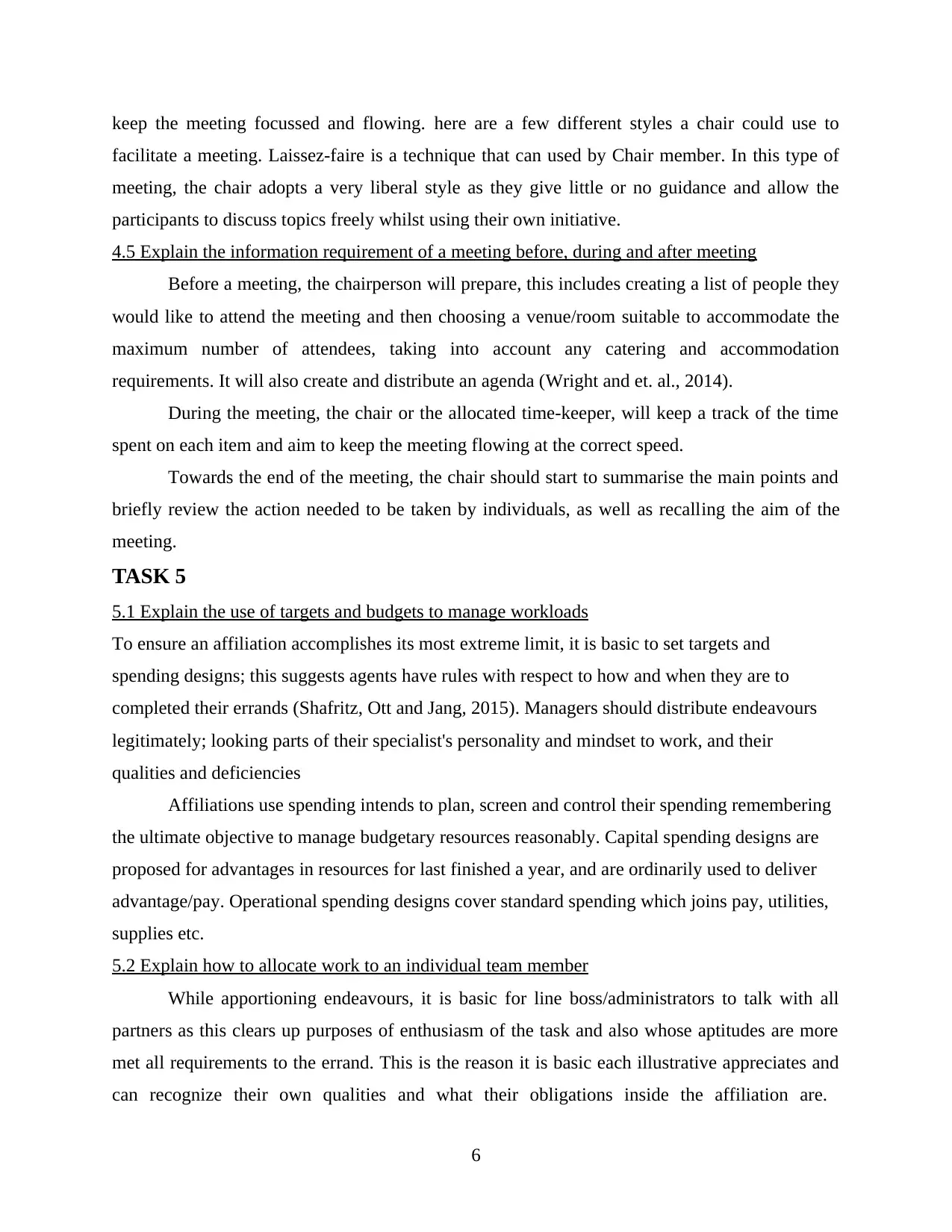
keep the meeting focussed and flowing. here are a few different styles a chair could use to
facilitate a meeting. Laissez-faire is a technique that can used by Chair member. In this type of
meeting, the chair adopts a very liberal style as they give little or no guidance and allow the
participants to discuss topics freely whilst using their own initiative.
4.5 Explain the information requirement of a meeting before, during and after meeting
Before a meeting, the chairperson will prepare, this includes creating a list of people they
would like to attend the meeting and then choosing a venue/room suitable to accommodate the
maximum number of attendees, taking into account any catering and accommodation
requirements. It will also create and distribute an agenda (Wright and et. al., 2014).
During the meeting, the chair or the allocated time-keeper, will keep a track of the time
spent on each item and aim to keep the meeting flowing at the correct speed.
Towards the end of the meeting, the chair should start to summarise the main points and
briefly review the action needed to be taken by individuals, as well as recalling the aim of the
meeting.
TASK 5
5.1 Explain the use of targets and budgets to manage workloads
To ensure an affiliation accomplishes its most extreme limit, it is basic to set targets and
spending designs; this suggests agents have rules with respect to how and when they are to
completed their errands (Shafritz, Ott and Jang, 2015). Managers should distribute endeavours
legitimately; looking parts of their specialist's personality and mindset to work, and their
qualities and deficiencies
Affiliations use spending intends to plan, screen and control their spending remembering
the ultimate objective to manage budgetary resources reasonably. Capital spending designs are
proposed for advantages in resources for last finished a year, and are ordinarily used to deliver
advantage/pay. Operational spending designs cover standard spending which joins pay, utilities,
supplies etc.
5.2 Explain how to allocate work to an individual team member
While apportioning endeavours, it is basic for line boss/administrators to talk with all
partners as this clears up purposes of enthusiasm of the task and also whose aptitudes are more
met all requirements to the errand. This is the reason it is basic each illustrative appreciates and
can recognize their own qualities and what their obligations inside the affiliation are.
6
facilitate a meeting. Laissez-faire is a technique that can used by Chair member. In this type of
meeting, the chair adopts a very liberal style as they give little or no guidance and allow the
participants to discuss topics freely whilst using their own initiative.
4.5 Explain the information requirement of a meeting before, during and after meeting
Before a meeting, the chairperson will prepare, this includes creating a list of people they
would like to attend the meeting and then choosing a venue/room suitable to accommodate the
maximum number of attendees, taking into account any catering and accommodation
requirements. It will also create and distribute an agenda (Wright and et. al., 2014).
During the meeting, the chair or the allocated time-keeper, will keep a track of the time
spent on each item and aim to keep the meeting flowing at the correct speed.
Towards the end of the meeting, the chair should start to summarise the main points and
briefly review the action needed to be taken by individuals, as well as recalling the aim of the
meeting.
TASK 5
5.1 Explain the use of targets and budgets to manage workloads
To ensure an affiliation accomplishes its most extreme limit, it is basic to set targets and
spending designs; this suggests agents have rules with respect to how and when they are to
completed their errands (Shafritz, Ott and Jang, 2015). Managers should distribute endeavours
legitimately; looking parts of their specialist's personality and mindset to work, and their
qualities and deficiencies
Affiliations use spending intends to plan, screen and control their spending remembering
the ultimate objective to manage budgetary resources reasonably. Capital spending designs are
proposed for advantages in resources for last finished a year, and are ordinarily used to deliver
advantage/pay. Operational spending designs cover standard spending which joins pay, utilities,
supplies etc.
5.2 Explain how to allocate work to an individual team member
While apportioning endeavours, it is basic for line boss/administrators to talk with all
partners as this clears up purposes of enthusiasm of the task and also whose aptitudes are more
met all requirements to the errand. This is the reason it is basic each illustrative appreciates and
can recognize their own qualities and what their obligations inside the affiliation are.
6
⊘ This is a preview!⊘
Do you want full access?
Subscribe today to unlock all pages.

Trusted by 1+ million students worldwide
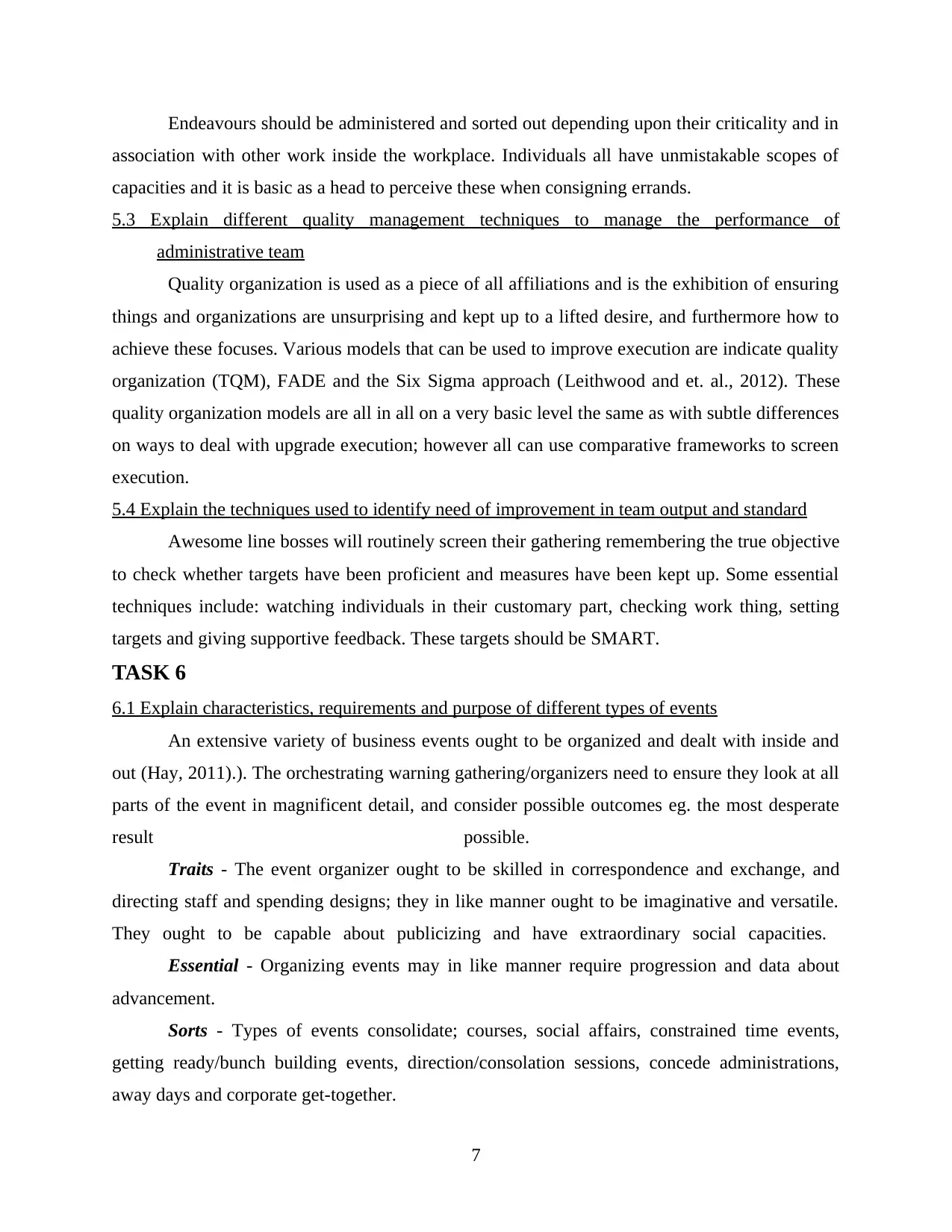
Endeavours should be administered and sorted out depending upon their criticality and in
association with other work inside the workplace. Individuals all have unmistakable scopes of
capacities and it is basic as a head to perceive these when consigning errands.
5.3 Explain different quality management techniques to manage the performance of
administrative team
Quality organization is used as a piece of all affiliations and is the exhibition of ensuring
things and organizations are unsurprising and kept up to a lifted desire, and furthermore how to
achieve these focuses. Various models that can be used to improve execution are indicate quality
organization (TQM), FADE and the Six Sigma approach (Leithwood and et. al., 2012). These
quality organization models are all in all on a very basic level the same as with subtle differences
on ways to deal with upgrade execution; however all can use comparative frameworks to screen
execution.
5.4 Explain the techniques used to identify need of improvement in team output and standard
Awesome line bosses will routinely screen their gathering remembering the true objective
to check whether targets have been proficient and measures have been kept up. Some essential
techniques include: watching individuals in their customary part, checking work thing, setting
targets and giving supportive feedback. These targets should be SMART.
TASK 6
6.1 Explain characteristics, requirements and purpose of different types of events
An extensive variety of business events ought to be organized and dealt with inside and
out (Hay, 2011).). The orchestrating warning gathering/organizers need to ensure they look at all
parts of the event in magnificent detail, and consider possible outcomes eg. the most desperate
result possible.
Traits - The event organizer ought to be skilled in correspondence and exchange, and
directing staff and spending designs; they in like manner ought to be imaginative and versatile.
They ought to be capable about publicizing and have extraordinary social capacities.
Essential - Organizing events may in like manner require progression and data about
advancement.
Sorts - Types of events consolidate; courses, social affairs, constrained time events,
getting ready/bunch building events, direction/consolation sessions, concede administrations,
away days and corporate get-together.
7
association with other work inside the workplace. Individuals all have unmistakable scopes of
capacities and it is basic as a head to perceive these when consigning errands.
5.3 Explain different quality management techniques to manage the performance of
administrative team
Quality organization is used as a piece of all affiliations and is the exhibition of ensuring
things and organizations are unsurprising and kept up to a lifted desire, and furthermore how to
achieve these focuses. Various models that can be used to improve execution are indicate quality
organization (TQM), FADE and the Six Sigma approach (Leithwood and et. al., 2012). These
quality organization models are all in all on a very basic level the same as with subtle differences
on ways to deal with upgrade execution; however all can use comparative frameworks to screen
execution.
5.4 Explain the techniques used to identify need of improvement in team output and standard
Awesome line bosses will routinely screen their gathering remembering the true objective
to check whether targets have been proficient and measures have been kept up. Some essential
techniques include: watching individuals in their customary part, checking work thing, setting
targets and giving supportive feedback. These targets should be SMART.
TASK 6
6.1 Explain characteristics, requirements and purpose of different types of events
An extensive variety of business events ought to be organized and dealt with inside and
out (Hay, 2011).). The orchestrating warning gathering/organizers need to ensure they look at all
parts of the event in magnificent detail, and consider possible outcomes eg. the most desperate
result possible.
Traits - The event organizer ought to be skilled in correspondence and exchange, and
directing staff and spending designs; they in like manner ought to be imaginative and versatile.
They ought to be capable about publicizing and have extraordinary social capacities.
Essential - Organizing events may in like manner require progression and data about
advancement.
Sorts - Types of events consolidate; courses, social affairs, constrained time events,
getting ready/bunch building events, direction/consolation sessions, concede administrations,
away days and corporate get-together.
7
Paraphrase This Document
Need a fresh take? Get an instant paraphrase of this document with our AI Paraphraser
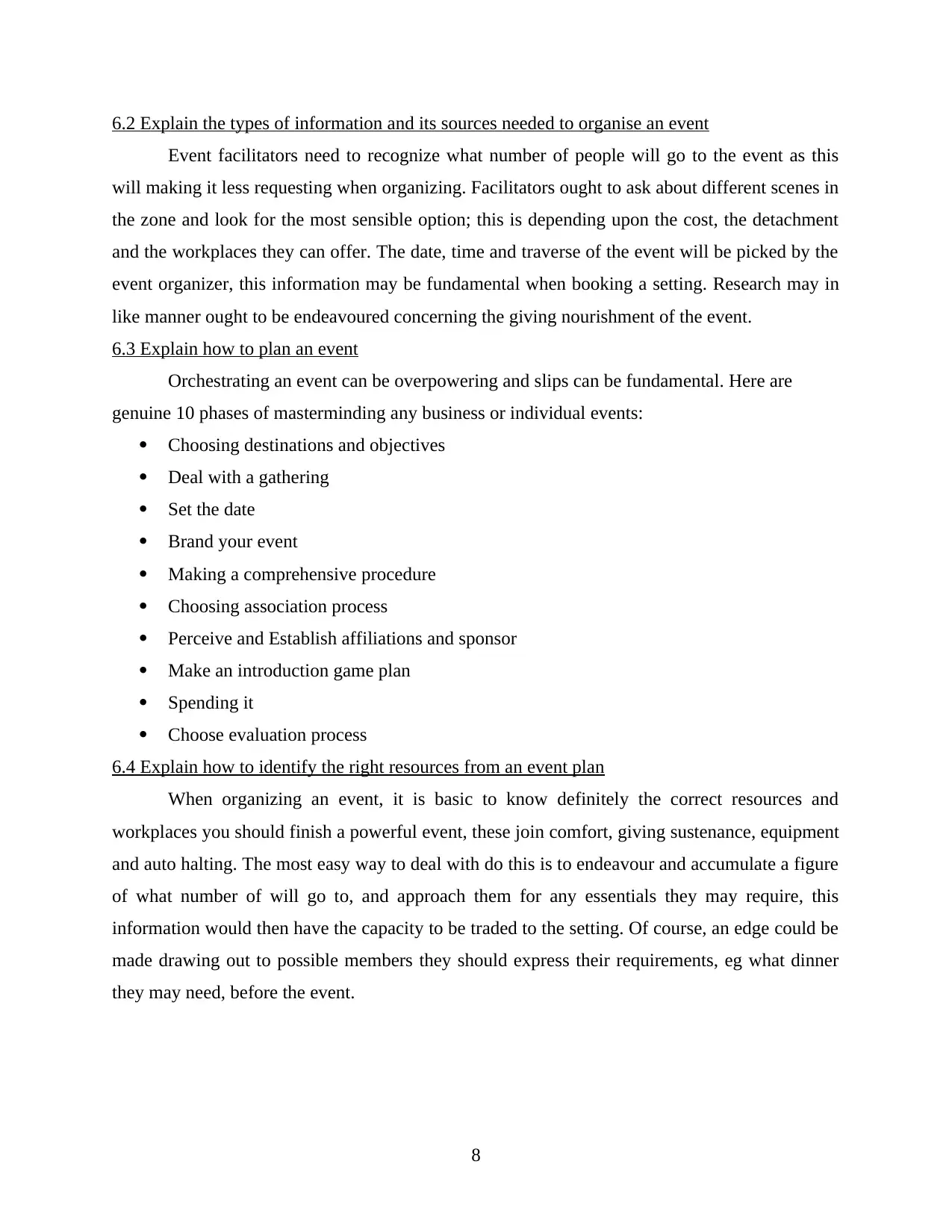
6.2 Explain the types of information and its sources needed to organise an event
Event facilitators need to recognize what number of people will go to the event as this
will making it less requesting when organizing. Facilitators ought to ask about different scenes in
the zone and look for the most sensible option; this is depending upon the cost, the detachment
and the workplaces they can offer. The date, time and traverse of the event will be picked by the
event organizer, this information may be fundamental when booking a setting. Research may in
like manner ought to be endeavoured concerning the giving nourishment of the event.
6.3 Explain how to plan an event
Orchestrating an event can be overpowering and slips can be fundamental. Here are
genuine 10 phases of masterminding any business or individual events:
Choosing destinations and objectives
Deal with a gathering
Set the date
Brand your event
Making a comprehensive procedure
Choosing association process
Perceive and Establish affiliations and sponsor
Make an introduction game plan
Spending it
Choose evaluation process
6.4 Explain how to identify the right resources from an event plan
When organizing an event, it is basic to know definitely the correct resources and
workplaces you should finish a powerful event, these join comfort, giving sustenance, equipment
and auto halting. The most easy way to deal with do this is to endeavour and accumulate a figure
of what number of will go to, and approach them for any essentials they may require, this
information would then have the capacity to be traded to the setting. Of course, an edge could be
made drawing out to possible members they should express their requirements, eg what dinner
they may need, before the event.
8
Event facilitators need to recognize what number of people will go to the event as this
will making it less requesting when organizing. Facilitators ought to ask about different scenes in
the zone and look for the most sensible option; this is depending upon the cost, the detachment
and the workplaces they can offer. The date, time and traverse of the event will be picked by the
event organizer, this information may be fundamental when booking a setting. Research may in
like manner ought to be endeavoured concerning the giving nourishment of the event.
6.3 Explain how to plan an event
Orchestrating an event can be overpowering and slips can be fundamental. Here are
genuine 10 phases of masterminding any business or individual events:
Choosing destinations and objectives
Deal with a gathering
Set the date
Brand your event
Making a comprehensive procedure
Choosing association process
Perceive and Establish affiliations and sponsor
Make an introduction game plan
Spending it
Choose evaluation process
6.4 Explain how to identify the right resources from an event plan
When organizing an event, it is basic to know definitely the correct resources and
workplaces you should finish a powerful event, these join comfort, giving sustenance, equipment
and auto halting. The most easy way to deal with do this is to endeavour and accumulate a figure
of what number of will go to, and approach them for any essentials they may require, this
information would then have the capacity to be traded to the setting. Of course, an edge could be
made drawing out to possible members they should express their requirements, eg what dinner
they may need, before the event.
8
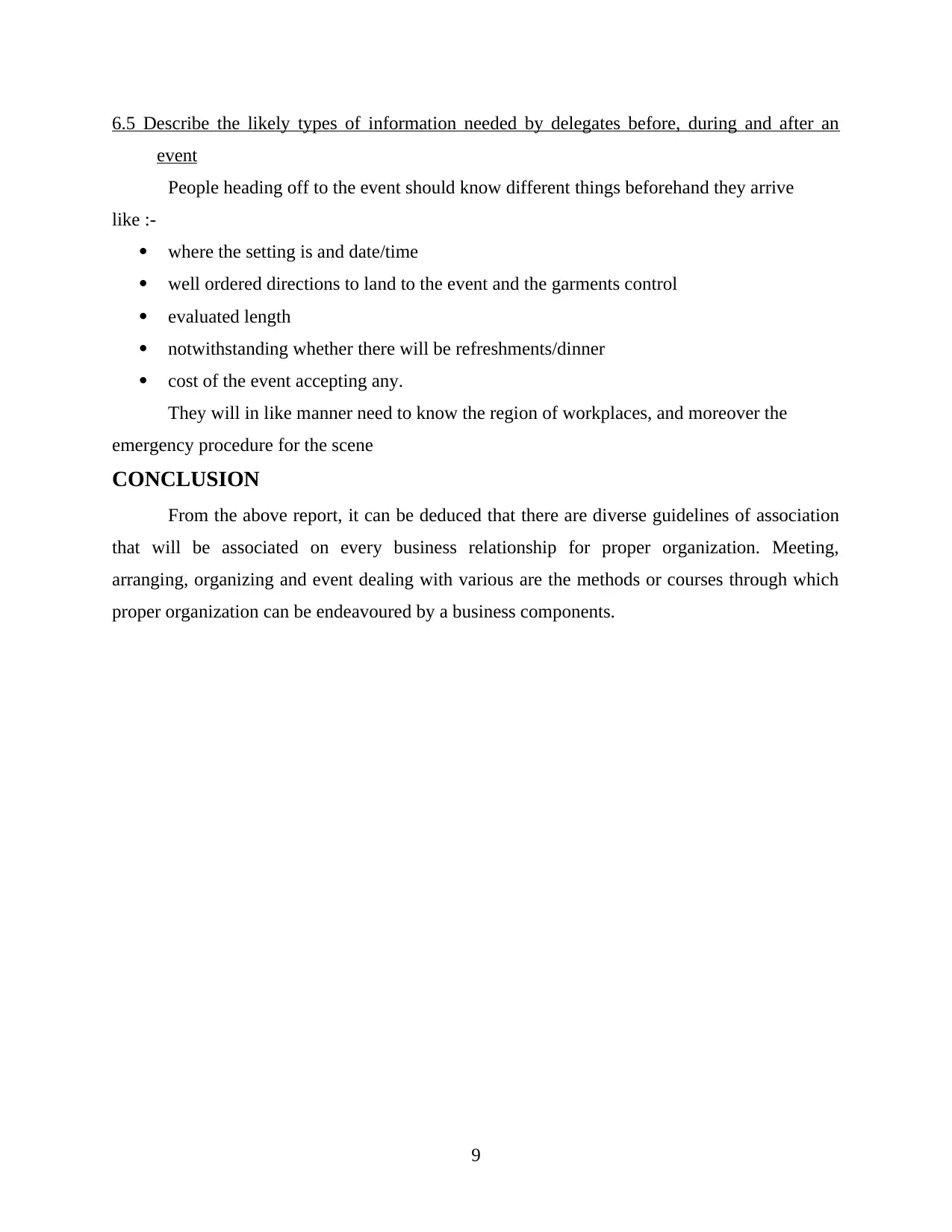
6.5 Describe the likely types of information needed by delegates before, during and after an
event
People heading off to the event should know different things beforehand they arrive
like :-
where the setting is and date/time
well ordered directions to land to the event and the garments control
evaluated length
notwithstanding whether there will be refreshments/dinner
cost of the event accepting any.
They will in like manner need to know the region of workplaces, and moreover the
emergency procedure for the scene
CONCLUSION
From the above report, it can be deduced that there are diverse guidelines of association
that will be associated on every business relationship for proper organization. Meeting,
arranging, organizing and event dealing with various are the methods or courses through which
proper organization can be endeavoured by a business components.
9
event
People heading off to the event should know different things beforehand they arrive
like :-
where the setting is and date/time
well ordered directions to land to the event and the garments control
evaluated length
notwithstanding whether there will be refreshments/dinner
cost of the event accepting any.
They will in like manner need to know the region of workplaces, and moreover the
emergency procedure for the scene
CONCLUSION
From the above report, it can be deduced that there are diverse guidelines of association
that will be associated on every business relationship for proper organization. Meeting,
arranging, organizing and event dealing with various are the methods or courses through which
proper organization can be endeavoured by a business components.
9
⊘ This is a preview!⊘
Do you want full access?
Subscribe today to unlock all pages.

Trusted by 1+ million students worldwide
1 out of 14
Related Documents
Your All-in-One AI-Powered Toolkit for Academic Success.
+13062052269
info@desklib.com
Available 24*7 on WhatsApp / Email
![[object Object]](/_next/static/media/star-bottom.7253800d.svg)
Unlock your academic potential
Copyright © 2020–2025 A2Z Services. All Rights Reserved. Developed and managed by ZUCOL.





